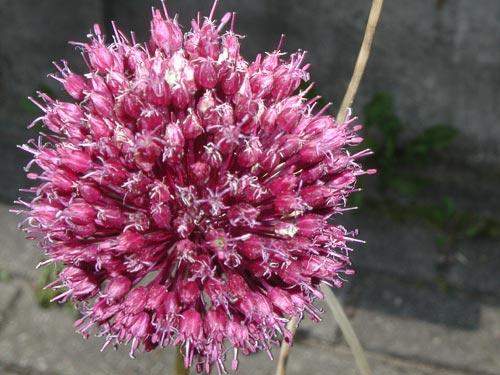Relatives
Allium atroviolaceum Boiss. - Black-violet leek.
Taxonomic position.
Family Alliaceae J.Agardh genus Allium L.Synonyms.
A. ampeloprasum var. atroviolaceum Regel., A. atroviolaceum var. caucasicum Somm. & Lev.Morphology and biology.
Herbaceous, perennial, bulbous plant. Bulb is ovoid-globular with grayish-brown, indistinct, reticular outer tunics. Numerous alternate bulbils are yellow-brown or yellowish, dull. Stem is 60-100 cm in length, with smooth leaf sheaths 0.25-0.5 cm long. Leaves are 4-5 in number, broadly linear, non-fistular. Umbel is globular, polyanthous, dense. Pedicels are 3-6 times longer than the perianth and vary in length, the inner ones twice as long as the outer. Sepals are dark purple-violet, less frequently dirty green, almost identical in size, 3-4 mm long, glossy, obtuse. Filaments, ciliate at the base, are 0.25 or 1.25 times longer than the sepals. Blossoms in June/July. Entomophilous. Propagated by seed or bulbs.Distribution.
Crimea, Caucasus (Ante-Caucasus, Daghestan, Trans-Caucasus), Middle Asia (Mountainous Turkmenistan, Syr-Darya foothill areas), and Iran.Ecology.
Grows in mid-mountain zones on dry sites and rocks, in crop fields, orchards and vineyards, as well as in weedy places. Prefers clay soils.Utilization and economic value.
Used as food (vegetable), as a source of vitamins, and nfor ornamental purposes (landscaping flowerbeds and rock gardens). Useful properties of this species have not been studied adequately.Reference citations:
Fedchenko, B.A. & M.G. Popova, eds. 1932. Flora of Turkmenia. Issue 2. Leningrad: Publishing House of the USSR Academy of Sciences. V. 1: 283-284. (In Russian)Grossgeim, A.A. 1940. Flora of the Caucasus. Baku: Publishing House AzFAS. V. 2: 120. (In Russian)
Vvedensky, A.I. 1935. Onion-Allium L. In: Flora of the USSR. Leningrad: Publishing House of the USSR Academy of Sciences. V. 4: 252. (In Russian)


